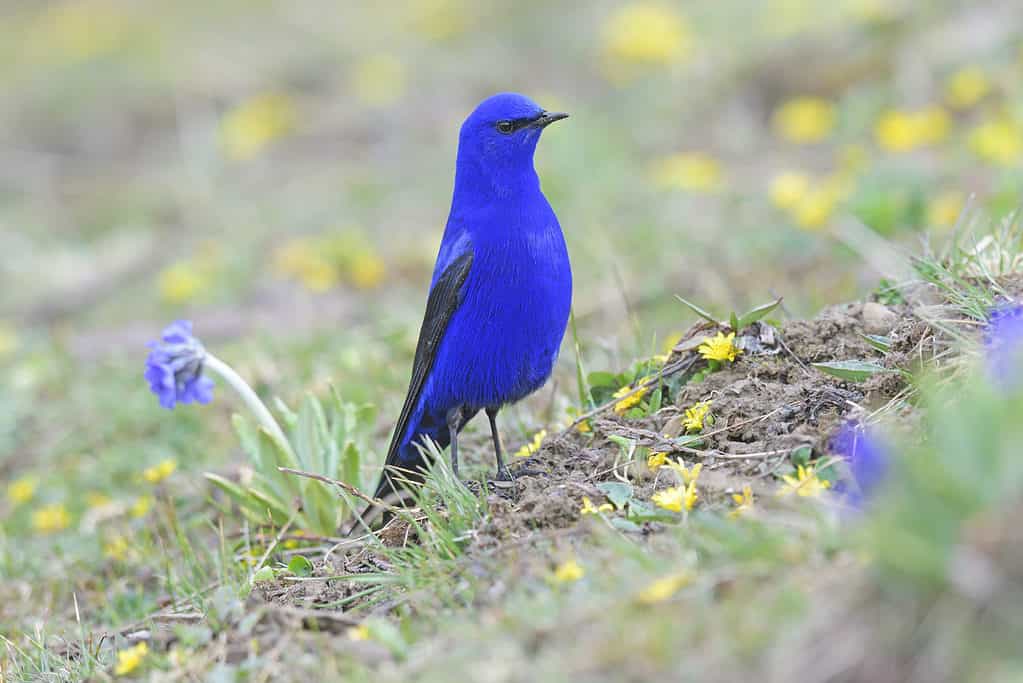Secretary Bird
The secretary is the type of bird you must see to believe. With its long, slender legs, luscious eyelashes, and fancy updo, the secretary bird commands attention in its grassland habitat. They are very large birds with heads like an eagle and legs like a crane. This bird has gray, white, and black plumage, with red and yellow faces. You can find them in Sub-Saharan Africa year-round, where they inhabit grasslands, shrublands, and savannas. This bird is notorious for its unusual hunting technique, where it stomps its prey with its feet.
Bohemian Waxwing
The Bohemian waxwing’s plumage is as smooth as butter, and its bright waxy colors bring character to winter roosting trees. It features a short tail, long wings, and a conspicuous crest. And it has grayish-brown plumage, black eye masks, cinnamon-colored face patches, and yellow tail bands. The wings are black with yellow and white markings, and the secondary feathers end in long red appendages that look like dripping wax. The Bohemian waxwing is native to North America and Eurasia, where it inhabits mature forests, parks, gardens, and woodland edges.
Blue-crowned Pigeon
If there was ever an award for “best-dressed bird,” the blue-crowned pigeon would win (hence the crown). This large pigeon is grayish-blue and features a light-blue lacey crest atop its head. It has bright red eyes with dark blue eye masks and patches of purple and white on its back. They are endemic to lowland rainforests in New Guinea, where they are often hunted for their plumes. Unfortunately, this species is listed as vulnerable due to hunting and habitat loss.
Lilac-breasted Roller
Bright iridescence shimmers as the lilac-breasted roller perches in grassy clearings. This African bird features a large head and unmistakable plumage. The head and back are olive, the throat and breast are lilac, the undersides are teal, and the alula feather is royal blue. Look for them in open woodlands and savannas in southern and eastern Africa. They perch on the tops of trees alone or in pairs, spending their days searching for insects and amphibians.
Long-tailed Widowbird
“Long-tailed “ is an understatement when describing the widowbird. Its body is of medium length, and its extremely long, broad tail reaches 20 inches long. Males are entirely black with orange-red shoulders and white wing coverts. And females have a more subdued coloration, with streaky upper portions. These birds live in distinct populations in Africa, including Kenya, Angola, Zaire, Zambia, and South Africa. They live in swampy grasslands in small flocks, where they forage on the ground for seeds and arthropods.
Quetzal
Despite their colorful and vibrant plumage, the quetzal blends perfectly with its environment. This species belongs to the Trogon family and is indigenous to Mexico, where you can find them in humid highland forests. Quetzals have iridescent green wings, backs, chests, and heads, with red bellies. Their feathers appear wet and shiny, blending well in rainy conditions, making it difficult to spot them in moist environments. They typically live alone and feed on fruits, berries, vertebrates, and insects.
Wood Duck
Wood ducks are one of the most colorful waterbirds in North America. These medium-sized perching ducks are related to the Mandarin duck and feature multicolored iridescent feathers. Males are a mix of brown, white, gold, green, red, yellow, black, teal, and royal blue, while females are much less colorful. This species lives near water in the United States, Canada, and Mexico, where they inhabit wooded swamps, marshes, shallow lakes, ponds, and creeks. They have sharp claws to help them perch on trees and spend their time feeding on the water or foraging on dry ground. Wood ducks primarily eat berries, seeds, and acorns.
Grandala
The grandala is a species of thrush and the only one in its genus. This stunning bird is a deep vibrant blue with black wings and tails. However, only the males feature bright colors. Females are much duller, with brown plumage and white stripes. They have vast territories ranging across northeast India in the low to mid-Himalayas. You will find them in small flocks perched in trees.
Splendid Fairy Wren
The splendid fairy wren belongs to the Australasian wren family and is found across most of Australia. They inhabit many environments but require abundant vegetation for shelter. You can find them in forests, dry scrub, and other arid to semi-arid zones. These tiny birds have long tails and feature violet-blue, black, white, and brown plumage. The splendid wren is much louder than other wren species, and females even emit a purring sound while brooding.
Ribbon-tailed Astrapia
